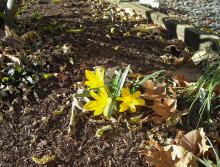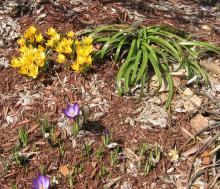Having tried Sternbergia lutea a few times here with no success, I would like to ask what is the coldest zone in which it is found to be hardy? Are there other species that might be hardier?
Comments
Re: Sternbergia
Having tried Sternbergia lutea a few times here with no success, I would like to ask what is the coldest zone in which it is found to be hardy? Are there other species that might be hardier?
Lori, I currently grow only the one species, Sternbergia lutea. It's been faithfully flowering each autumn for the last 10 years or so. It is planted on the south facing side of my house, about 2' from the foundation, in a slightly raised mound, planted under a large Hibiscus syriacus shrub thus shaded in summer (and kept dry by the shrub too). No sign of life just yet, too early (last year, it flowered early November). So, it is hardy to at least USDA Zone 5 given my experience. And no matter how harsh and frigid winter is, the foliage always remains perfectly evergreen, so I guess this species could be at least hardy to USDA Zone 4.
For several years (5-6) I also grew Sternbergia fischeriana, a really stunning species, with largish wide falcate leaves, looking like a daffodil, and gorgeous yellow flowers. It eventually stopped flowering, then died out, due to becoming shaded out by an encroaching Rhododendron, and I neglected to rescue it. :'(
Re: Sternbergia
I can let you know they don't survive in Newfoundland either :'(
Re: Sternbergia
Thanks for the input, all.
I'd be very keen to know if any local gardeners have tried it, successfully or not.
Re: Sternbergia
I don't think that Sternbergia would grow in zone 3. They grow their foliage in the Fall and grow all Winter. The foliage would freeze off or be covered with snow in zone 3 and the plant would not have enough energy to survive that would be your main problem. I grow them very well here in Oregon but the temperature rarely get down to 10 Deg F. and when it does it is only for a few days. They can handle as much rain as you can throw at them as long as the soil drains fast. The Pacific Northwest gets anywhere from 40-53 inches (3-4 feet) of rain from Fall To Spring with dry summers. Rain should be no problem but the leaves have to stay alive in the winter or they will just slowly rot away.
Re: Sternbergia
Hello Reed, welcome to the NARGS Forum!
On Sternbergia, I can only speak to the 2 species I've grown, fischeriana and lutea, and I'm not sure about Sternbergia hardiness in Zone 3, but here in Zone 5 in northern Massachusetts, Sternbergia lutea has amazingly winter-resistant evergreen foliage. Even with months of freezing, and I'm talking about deep freezing, ice, snow, and growing in an area that can be windswept clear of snow, the foliage on S. lutea remains healthy, shiny and fresh looking. Just checked my photo records over a number of year, and I have many photos such as the two I show here, taken in March after a winter battering, the foliage looks pretty darn good. The crocus growing next to it is one of the earliest flowering species, C vitellinus. My S. lutea have been there for 10 years and flower every autumn.
Re: Sternbergia
Hello McDonough, and thank you for the welcome.
I don't doubt they can withstand very cold temperatures (I have seen them growing in very cold areas with no ill effects). I was just wondering if the plants that Skulski is growing are covered in snow from early fall to late spring because without any energy from the sun they would slowly begin to decline without the necessary glucose reserves. One other thing we would need to know is when the bulbs where dug and planted since most (not all) bulb companies sell them at the wrong time of year and as a result they do poorly and it leads people to believe they can't grow them (Colchicum are a prime example).
Re: Sternbergia
Interesting... last time I tried planting S. lutea, I seem to recall seeing a unfamiliar shoot starting to emerge in late fall, that was, evidently, killed later on. We usually don't have consistent or thick snow cover here - snow cover is usually thin and patchy, with melting caused by frequent chinooks (though the last 2 years have been quite the opposite of the norm, with thick, lasting snow). (By contrast, the common (hardiest?) species/cultivars of Colchicum do OK here, even with fall planting.)




I have tried Sternbergia lutea too but the problem here is too much water in the winter, not the cold I suppose.